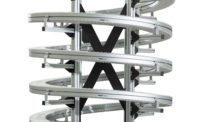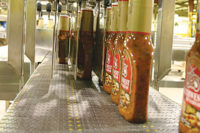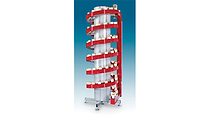Conveyor solutions extend beyond original equipment
Drive systems, lubricants keep conveyors moving along

To keep conveyor belts moving smoothly, operations managers depend on effective lubrication products. (Image courtesy of Klüber Lubrication NA LP)
In beverage processing and packaging operations, each step is dependent upon operating in sync with one another in order to ensure that all processes work properly. To help keep operations on task, beverage manufacturers and distributors are seeing an increased need to have accumulation systems support their conveying solutions.
In a white paper titled “Selecting the right accumulation conveyor” by Tim Kraus, manager of product management for Intelligrated, and Jonathan Lim, product manager for Intelligrated, the two experts highlight the importance of accumulation systems.
“Accumulation conveyors can be critical equipment in a material handling system, providing buffer zones to hold product until downstream operations have available capacity,” the white paper states. “Advanced solutions yield highthroughput, high-density accumulation of the most challenging mix of product sizes, shapes and weights while preserving product integrity.”
For automated operations, Kraus and Lim identified three accumulation conveyors from which manufacturers can choose: medium-pressure, zero-pressure and zero-contact.
“Medium-pressure accumulation conveyors are typically most effective when handling the same or similar-size products capable of withstanding slight back pressure without sustaining damage,” the white paper states. “In applications with different-size products, the back pressure may cause wider products to pivot around smaller items during accumulation, resulting in side-by-sides and downstream operational problems.”
Kraus and Lim note that when the product mix consists of a varying range of sizes and weights, manufacturers should select zero-pressure accumulation conveyors.
“In a zero-pressure accumulation conveyor system, items coast to a stop and contact the next downstream item,” the white paper states. “After accumulation, there should be no driving pressure on accumulated items, hence the term ‘zero-pressure’ accumulation.”
Finally, zero-contact accumulation conveyors feature segregated zones and operate on one or two motor driven rollers (MDR), which control the accumulation zone, Kraus and Lim detail.
“MDR conveyors use ‘run-on-demand’ technology that provides significant energy savings, only operating when necessary to move product to the next zone,” the white paper states. “Other benefits include low operating noise and no back pressure on the accumulated product. However, this approach does offer a lower throughput rate compared to medium-pressure and zero-pressure accumulation.”
Driving conveyor systems
Suppliers to conveyor original equipment manufacturers (OEMs) are accommodating this evolution in conveyor solutions, while still supporting the OEMs traditional offerings.
“On the last couple years, we have noticed an increase demand on accumulation conveyor systems as well as standard belt conveyors,” says Alex Kanaris, president for Van der Graaf (VDG), Brampton, Ontario. “For VDG that has been a positive challenge by justifying new investments in [research and development] (R&D) and production technology.”
Among the components that VDG supplies to conveyor OEMs are drum motors, a one component conveyor drive where the motor, gear drive and all moving parts are enclosed inside the drum, the company says.
Kanaris explains that containing all the moving parts within a conveyor drive system has become an important product attribute in the name of warehouse safety.
“The new technological advancements in the conveyor drives is a drive design that have no external components outside of the conveyor frame,” he says. “All drive components like electric motor and gear reducer components [are] to be housed within the head roller and make it difficult for anybody [who] works around the conveyor to be physically injured.”
Kanaris encourages beverage operations managers to consider the value that drum motors can offer to their flow chain. “The advice that we can give to the operation managers is to select drum motors as conveyor drives and benefit of the safety, efficiency, and maintenance-free operation that the drum motors drives provide,” he says.
At the ProMat tradeshow, Waunakee, Wis.-based NORD Gear Corp. also highlighted the importance of drive systems. The company highlighted its LOGIDRIVE integrated drive technologies, which support IE4 permanent magnet synchronous motors and decentralized variable frequency drives (VFDs). The company explains that the VFDs and IE4 motors thereby support speed ranges through gearboxes, which help deliver automation to varying platforms including chain conveyors and roller conveyors.
Moving up
Real estate within beverage warehouses is becoming more and more valuable as storage and automation systems command more space. For years, conveyor manufacturers have touted the benefits of spiral conveyor systems for companies that are large and small.
In a Feb. 22 blog post titled “Super Compact Narrow Trak Spirals for Canadian Brewery,” the Yorktown, Va.-based Ryson Spiral Team details how its Narrow Trak Spiral Conveyors can be an ideal solution for companies that have smaller-sized load capacities.
“The integrator’s application of our Narrow Trak Spirals save space by eliminating the need for an incline belt conveyor and will reduce implementation costs, as the spirals ship totally pre-assembled,” the blog post states.
The company also exhibited at the recent ProMat tradeshow where it showcased a fully operating demo loop including two high-capacity spiral conveyors with induction and divert-out conveyors that featured intermediate elevations, the company reported in an April 11 blog post.
Newer features of its conveyors include extended in or outfeed tangents, MDR induction conveyor with friction coated rollers, divert arm with powered belt surface and special rounded (button) friction inserts.
Arlington, Texas-based AmbaFlex Inc. also is serving the needs for elevated conveyor systems. For single file product flow, the company offers the SpiralVeyor SV Series. For mass-flow handling, AmbaFlex offers SpiralVeyor SVm-Series, which feature wide belt spiral conveyors.
Running smoothly
Efficiently running conveyor systems don’t just rely on mechanical components. To keep the belts moving smoothly, operations managers depend on effective lubrication products.
“Lubrication of belt conveyor systems is one of the critical challenges which food and beverage producers face in improving operational efficiency,” says Marius Czech, food market manager for Londonderry, N.H.-based Klüber Lubrication NA LP. “Other, equally important objectives include saving water and meeting sustainability objectives. The challenge for conveyor lubrication is posed by three application points, which need to be lubricated effectively.
“Friction occurs between the packing material and conveyor belts, between the chain joints and between the conveyor chain and conveyor support slide bar,” he continues. “A lubricant should prevent wear in these three areas and also minimize the coefficient of friction.”
For today’s lubrication needs in beverage operations, Czech highlights that companies need a product that offers great performance as well as cleaning effects. To support these trends, Klüber offers its Klüberplus C2 PM2 Ultra Dry.
“The Klüberplus C2 PM2 Ultra Dry for conveyor lubricants has been developed for carton, PET and metal can lines,” he says. “All challenges currently faced by our customers and which are not addressed by existing conveyor lubricants were taken into account during product development. As a result, we have a product concept that has proven its worth both on test rigs and in field tests. The product has shown excellent performance in its core task as a lubricant, which is to reduce friction and wear.”
Czech notes that Klüberplus C2 PM2 Ultra Dry offers numerous benefits that support hygienic, efficient operations. “[Its benefits are] optimized wetting, consistent lubricant films on the conveyor, extremely low lubricant consumption, less residue formation on chains, better hygiene, cleaning effect [and] less additional cleaning required,” he says. BI
Looking for a reprint of this article?
From high-res PDFs to custom plaques, order your copy today!








